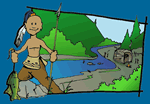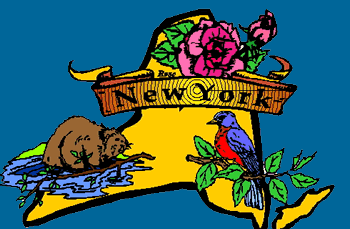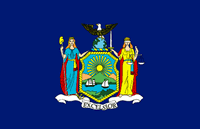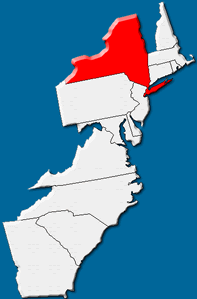


Geography and Landforms:
The geography of New York is diverse. The highest, most rugged mountains, the Adirondacks, are located in the northern part of the state between Lake Champlain in the east and Lake Ontario in the west. The St. Lawrence-Champlain lowlands can be found on the shores of Lake Ontario and running northeast along the St. Lawrence River and the Canadian border. South of the Adirondack uplands, the Hudson-Mohawk lowland follows the rivers north and west. This area is from 10 to 30 miles wide. In the southeast is the Atlantic coastal plain, and to the west of the Hudson River are the Appalachian Highlands that extend west toward Lake Erie. This area includes the Catskill Mountains and the Finger Lakes. Further west is the Erie-Ontario lowlands as New York slopes toward these two Great Lakes.
|
 History:
The first European explorer to visit the area now known as New York was Giovanni de Verrazano, who sailed into New York Bay in 1524. Henry Hudson, an English explorer in the service of the Dutch, was the first European to visit the river that would come to bear his name in 1609. Northern areas of New York were claimed for France by the explorer Samuel de Champlain. The first settlement in the area came soon after in 1624, when the Dutch established a colony near Albany called Fort Orange. About a year later, Peter Minuit purchased the island of Manhattan from Native Americans for trade goods worth about 60 Dutch gilders and called the area New Netherland. Forty years later, the English conquered the colony and renamed the area New York in honor of the Duke of York.
|
 Economy:
New York has been a leader in industry and in the national economy since the earliest times. Robert Fulton invented the first steam-powered ship in 1809, and this new technology began a new era in transportation. Soon after, in 1825, the completion of the Erie Canal connecting the Great Lakes with the harbor in New York City allowed trade across the state to flourish and a number of cities grew up along these trade routes.
By the 1880s, a system of roads and turnpikes across the state increased New York's ability to move goods along with the railroads that had become an important addition to the state economy.
|
 First Inhabitants:
When the first European explorer sailed into New York harbor in 1524, the native civilization found on the banks of the Hudson was a complex and ancient one. The natives' ancestors had entered the Hudson Valley some twelve thousand years earlier, after the last continental glacier receded from North America.
|
Books Related To New YorkThe King Of Mulberry Street - Donna Napoli Abuela - Arthur Dorros The Amazing and Death Defying Diary of Eugene Dingman - Paul Zindel Dear Primo: A Letter to my Cousin - Duncan Tonatiuh E is for Empire: A New York Alphabet - Ann Burg If You Come Softly - Jacqueline Woodson The Man Who Walked Between the Towers - Mordicai Gerstein My Side of the Mountain - Jean Craighead George The Planet of Junior Brown - Virginia Hamilton Safe at Home - Sharon Robinson Tar Beach - Faith Ringgold |
Famous Citizens:
|
| Capital: | Albany |
| Entered Union: | July 26, 1788 |
| Population: | 19,746,227 |
| Area | 54,556 |
| Bird | Bluebird |
| Flower | Rose |
| Nickname: | Empire State |
| Governor | Andrew Cuomo |
Places to Visit in New York: (Click the links to learn more.)
|



